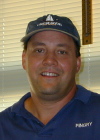
 William Bourne |
 Drew Burns |
 Charles Coe |
|
|
|
|
|
Physics 1 begins to acquaint the student with meticulous conceptual and mathematical analysis of physical phenomena. Physical laws pertaining to the fields of classical mechanics, wave motion, sound, light, electricity, magnetism, and (to a lesser extent) thermodynamics and modern physics are studied in historical and philosophical context, with extensive laboratory practice. Special emphasis is placed on developing a student's ability to answer scientific questions with clarity, to form cogent logical connections in an unambiguous manner, to use technical vocabulary properly, and to discuss the answer to the required depth.
Significant time is spent developing and reinforcing the required mathematical techniques, developing the skill of translating a physical situation into the appropriate mathematical relationship, and bolstering and extending the student's command of problem-solving methods. Topics such as trigonometry, accurate algebraic manipulation of equations, logarithmic and exponential functions, and proportional reasoning are practiced and applied to physical problems. In appropriate situations, students are introduced to the graphing calculator for data regression, numerical solutions to equations, and graphical representations of physical models. Contact these Physics 1 teachers for more information: Lab fee: $70-75 |
|
|
|
|
|
Honors Physics 1, like Physics 1, acquaints the student with the detailed conceptual and mathematical analysis of physical phenomena but at a more accelerated pace and with a greater degree of sophistication. Physical laws pertaining to the fields of Newtonian mechanics, waves (light, sound, and mechanical), optics, electricity, magnetism, thermodynamics, and modern physics are studied in historical and philosophical context with extensive laboratory practice. Students must answer scientific questions with clarity, form cogent logical connections in an unambiguous manner, use technical vocabulary properly and discuss answers to the required depth.
In contrast to Physics 1, students in Honors Physics are expected to have a greater degree of mathematical sophistication and physical intuition. Consequently, the course assumes that students possess a greater facility at translating a physical situation into the appropriate mathematical relationships and extends the students' command and range of these problem-solving methodologies. Topics such as trigonometry, accurate algebraic manipulation of equations, logarithmic and exponential functions, and proportional reasoning are practiced and applied to various physical phenomena. In appropriate situations, students are introduced to the graphing calculator for data regression, numerical solutions to equations, and graphical representations of physical models. Contact these Honors Physics 1 teachers for more information: Lab fee: $70-75 |
|
|
|
|
|
This course completes a two-year sequence (Physics I [or IA] and Advanced Physics) that exposes students to a full-year college-level (non-calculus intensive) physics curriculum. The concepts of classical physics (Newtonian mechanics, electricity, and magnetism) that were first investigated in Physics I or IA are revisited using more complicated physical systems (e.g., rotational kinematics and dynamics, compound optical instrumentation) and sophisticated mathematical approaches (e.g., Gauss's Law for the determination of electric field associated with non-point charge distributions, basic concepts of integral and differential calculus) with a special emphasis on the development of problem-solving skills and the relationship of mathematics to physical situations.
Advanced Physics also provides an in-depth exploration of modern physics, including but not limited to quantum mechanics, special relativity, nuclear and subatomic physics, and statistical thermodynamics. An important aspect of the course is the use of spreadsheet software for data regression via least-squares fits to appropriate models, numerical solutions of equations, and graphical representation of physical models. Graphing calculators are also used in a similar fashion. Students may choose to sit for either the Advanced Placement Physics C (Mechanics only) exam or the Physics B exam at the end of the year. In lieu of a final exam, a final project that requires the use of spreadsheet software to model and solve a variety of physical systems is required of all students. Contact these Advanced Physics teachers for more information: |
|
|
|
|
|
The goal of the class is to take an in-depth look at the physical, macroscopic world. Students learn to apply physical law and sophisticated mathematical techniques, acquiring the ability to observe phenomena, abstract general rules regarding their occurrence, analyze the phenomena both conceptually and mathematically, and predict the future course of such phenomena. The course syllabus is closely linked to the E.T.S. suggested syllabus for the A.P. C-level course, and thus students will be prepared to sit for that exam. Topics covered include formal vector notation, two- and three-dimensional statics, torque, kinematics with differential equations, dynamics, work and energy, impulse and momentum, rotational motion, gravitation (including elliptical orbits), simple and damped harmonic motion, static electricity, potential, electric field and Gauss's Law, DC circuit theory, magnetic field and force, electromagnetic induction, and a brief introduction to Maxwell's relations.
Extensive use is made of the graphing calculator for matrix solution of simultaneous equations, data regression via least-squares fits to appropriate models, numerical solutions of equations, and graphical representation of physical models. One of the major focuses of the course is the computer simulation of physical laboratory experiments using spreadsheets and commercially available physics-modeling software. Numerical integration is taught and various force relationships are studied. Contact these Advanced Placement Physics teachers for more information: Lab fee: $70-75 |
For a more complete description of science at Pingry, visit the Pingry Science page.